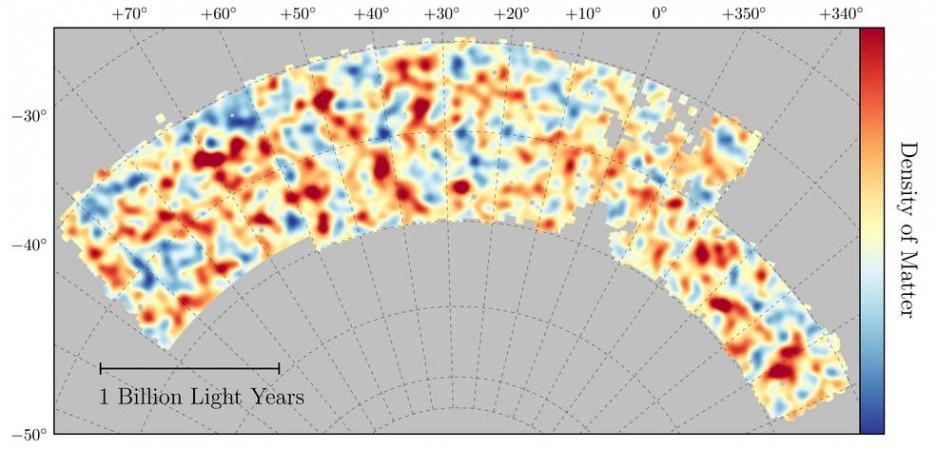
Astronomers have analysed over 26 million galaxies for creating a map showing the dark matter present in the cosmos.
Known as Dark Energy Survey (DES), it is the largest study carried forward to assess the dark matter so far.
ALSO READ: NASA's New Horizons to explore a mysterious Kuiper Belt Object: Here are top things to know
Top 7 things to know about Dark Energy Survey :
- An international collaboration was made by three NASA researchers from the Jet Propulsion Laboratory in Pasadena, California, with more than 400 scientists. DES aids in understanding the structure of the universe.
- The new findings from DES are important for the preparations of two upcoming space missions which will help in exploring the nature of the universe further, which will be carried out around 2020 by ESA's Euclid mission (which has significant NASA participation) and NASA's Wide-Field Infrared Survey Telescope mission.

Map of dark matter made from gravitational lensing measurements of 26 million galaxies in the Dark Energy Survey. The map covers about 1/30th of the entire sky and spans several billion light years in extent. Red regions have more dark matter than average, blue regions less dark matter.Chihway Chang/Kavli Institute for Cosmological Physics at the University of Chicago/DES Collaboration
"With this study, we are showcasing what's going to be possible with these much more complex observatories," said Andres Plazas Malagon, a postdoctoral researcher at JPL, who helped characterize DES's Dark Energy Camera detectors and who is also involved in detector studies for WFIRST.
3. The leading models of universe point towards the universe comprising dark energy and dark matter. The dark matter has the qualities similar to that of an invisible glue which holds the galaxies and galaxy clusters.
4. The composition of the recent universe has been observed by the DES, the recently collected data is close to the forecasts made using the measurements of the distant past using ESA's Planck satellite which aids the scientists to understand about the origination of the universe over 14 billion years.
"The Planck results have been the landmark constraints in cosmology. It is truly amazing that you have a model that describes the universe at 400,000 years old, and now we have a similarly precise measurement of the universe at 13 billion years [old] that agrees with the model," said JPL's Tim Eifler, who led the Dark Energy Survey analysis team to develop the science software for the interpretation of the results.
5. DES found no alteration in the amount of dark energy so far. According to the astronomers, around 70 percent of the energy present in the universe is contained in the dark energy and 25 percent of it comprises of the mysterious dark matter and the remaining comprises of normal matter.
6. "This is the crossover point where gravitational lensing and galaxy clustering measurements and surveys will be the primary driver of what we know about dark energy in the universe," said Eric Huff, a JPL researcher who invented a new method of extracting the weak lensing signal, enhancing the precision of the DES galaxy shape catalogs.
7. The DES team devised a new technique to detect tiny lensing distortions of galaxy images. The largest guide to spot dark matter in space was created by them int he process. A NASA statement quoted that the new dark matter map is 10 times the size of the one DES released in 2015 and continues to grow. Five times larger data set will be published by the DES collaboration over the next two years.
"There is a feeling of true discovery in the collaboration. For the first time, we have the data and tools in hand to see whether Einstein's cosmological constant prevails. We are all excited to explore the physical nature of dark energy," Eifler said. "In particular we want to see if there are hints in the data that suggest modifying the laws of gravity on the largest scales in the universe."


















